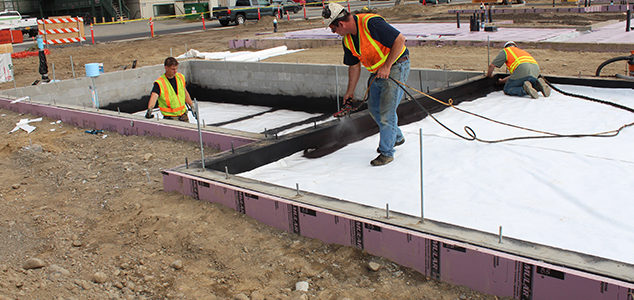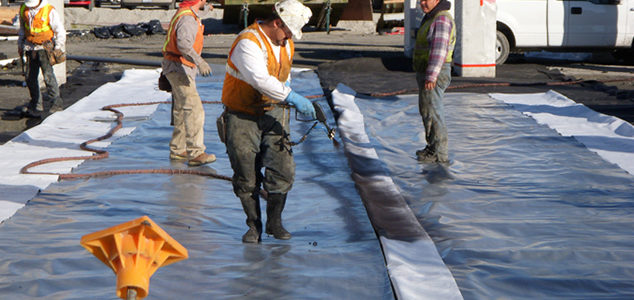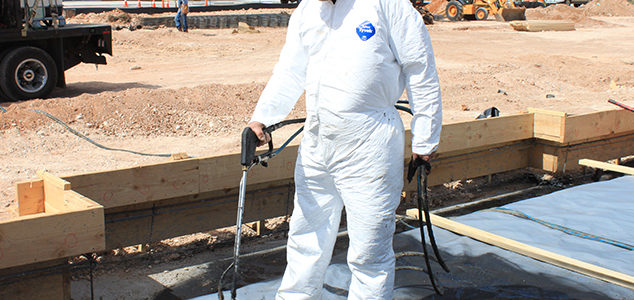Big Box Retail Store Receives “No Further Action” Status after Geo-Seal® Application
Geo-Seal was selected to mitigate vapor intrusion at a new retail development in Skokie, Illinois. The former industrial site was contaminated with chlorinated solvents (PCE, TCE, DCE and VC) and regulatory agencies required mitigation. A developer purchased the underutilized 15-acre light industrial business park for redevelopment and initial due diligence investigations identified numerous environmental issues on the property.
Kentucky Division of Waste Management Approves Geo-Seal® for Mitigating Vapor Intrusion to Redevelop Brownfield Property
Project Highlights
- Approved by Kentucky Division of Waste Management
- Approximately 142,000 square feet installed at brownfield site allowing for redevelopment to move forward
- Triple layer protection from chlorinated solvent vapors provides safe and reliable barrier for student housing
Project Summary
Student housing was to be constructed in Louisville, KY over 42 acres of vacant Brownfield property. Chlorinated solvents were discovered in the subsurface soil and groundwater beneath the proposed construction area and caused concern over potential indoor air vapor within the housing complex. Terracon Consultants, Inc. specified Geo-Seal® Vapor Intrusion Barrier and Vapor-Vent Trenchless Venting System in their risk management plan.
The Kentucky Division of Waste Management under the Kentucky Department of Environmental Protection evaluated the Geo-Seal vapor barrier along with other membranes and determined Geo-Seal to be an “excellent vapor intrusion barrier system” based on its ability to resist contaminant permeation and breakthrough. 142,000 square feet of Geo-Seal successfully installed.
Download the complete case study
© 2021 All rights reserved. Geo-Seal is a registered trademark of Epro Services Inc.
Geo-Seal® Receives State Approval From California Department of Toxic Substances Control
Project Highlights
- Geo-Seal® resists contaminant permeation breakthrough for a period 18X longer than simple asphalt/latex membranes
- Installation of 22,000 square feet
- California DTSC Approved
Project Summary
A senior housing facility was constructed over an existing benzene plume creating a concern for exposure to high levels of benzene vapors. Northgate Environmental, with the approval of the California Department of Toxic Substances Control (DTSC), selected Geo-Seal® vapor intrusion barrier to mitigate the vapor intrusion risk associated with the property.
Geo-Seal provides triple-layer protection and high puncture resistance by using two chemically resistant high density polyethylene (HDPE) layers encapsulating a spray-applied asphalt/latex membrane. Geo-Seal’s exceptional chemical resistance limits the transmission of volatile organic vapors through the membrane. 22,000 square feet was successfully installed at the site.
Download the complete case study
© 2021 All rights reserved. Geo-Seal is a registered trademark of Epro Services Inc.
Historic Site Transformed into Multi-Million Dollar Community Complex Following Installation of Geo‐Seal®
Project Highlights
- Approximately 100,000 square feet installed over four buildings in new Dayton, OH community complex
- Geo-Seal® CORE material successfully applied in 25 degree temperatures without artificial heating
- As part of the total square footage, applied 16,000 square feet to retrofit the basement of a +100 year old historic mansion
- Triple-layer protection provides maximum vapor intrusion protection to site
Project Summary
The Salvation Army Kroc Center is a multi-million dollar community complex on 17.5 acres. Dayton, OH was one of 29 cities to receive funding from the 1.1 billion dollar donation of the Ray Kroc Family for the development of community centers across the United States.
Environmental concerns arose from a neighboring groundwater plume migrating from a former industrial facility. Geo-Seal Vapor Intrusion Barrier and Vapor-Vent trenchless vent system were applied to protect the building from the threat of chlorinated solvent vapor intrusion and alleviate vapor buildup beneath the facility. The application was completed in November during 25 degree temperatures.
Download the complete case study
© 2021 All rights reserved. Geo-Seal is a registered trademark of Epro Services Inc.
Geo-Seal® and Vapor-Vent™ Approved to Protect Urban School Complex from Harmful PHC and cVOC Contaminants
Project Highlights
- Geo-Seal® applied to 40,000 square feet of new construction
- Geo-Seal and Vapor Vent™ approved by California Department of Toxic Substances Control
Project Summary
A former manufacturing facility site in Oakland, California was contaminated due to years of engine repair, vehicle maintenance and fuel storage that took place on the property. The site is currently being used as a school complex and the Oakland Board of Education approved construction of a modern facility. However, after a site assessment was completed, it was determined that high levels of petroleum hydrocarbons, PAHs and chlorinated solvents were present.
Ninyo and Moore prepared a Removal Action Work Plan and Operation and Maintenance plan for approval by the California Department of Toxic Substances Control. An excavation remediation plan was implemented on-site to dispose of the majority of the contaminated soil and groundwater. A vapor mitigation system was utilized to avoid any potential inhalation risk that remained. Geo-Seal and Vapor-Vent were applied to 40,000 square feet of new construction to mitigate the vapor intrusion risk and meet regulatory requirements.
Download the complete case study
© 2021 All rights reserved. Geo-Seal is a registered trademark of Epro Services Inc.
Large Manufacturing Facility Addresses Migrating cVOC Plume with Geo-Seal®
Project Highlights
- Geo-Seal®‘s triple‐layer protection consisted of spray‐applied membrane encapsulated with HDPE providing chemical resistance and ease of application
- 100,000 square feet of barrier successfully installed in 10 days, saving the owner three weeks of costly labor compared to the originally specified PVC sheet
- Smoke testing procedure ensured integrity of barrier and installation
Project Summary
A 104,000 square foot manufacturing facility required the use of a vapor barrier due to migrating chlorinated solvents in groundwater from a nearby plume. In addition to the vapor barrier, a 30 mil battened and welded PVC sheet was also specified for enhanced protection which required an extended installation time. Five weeks were estimated to install the PVC sheet due to a complex 20,000 square foot office area adjacent to the manufacturing facility.
To save time while delivering a safe and effective solution, Geo‐Seal Vapor Intrusion Barrier was installed and eliminated the need for the PVC sheet installation. Geo‐Seal contains a triple layer protection that includes a 60 mil spray-applied asphalt/latex layer encapsulated with two layers of high density polyethylene, providing a system that is chemically resistant yet easy to install.
Download the complete case study
© 2020 All rights reserved. Geo-Seal is a former registered trademark of REGENESIS. Geo-Seal is now a registered trademark of Epro Services Inc.
Upscale Grocer Selects Geo-Seal® to Protect Key Property Against Presence of Methane and VOCs
Land Science®, a leader in providing cost-effective, industry-leading vapor intrusion mitigation solutions, was chosen by a leading upscale grocer to provide a vapor mitigation system to protect against the presence of methane and volatile organic compounds (VOCs).
The grocer selected Geo-Seal for this project due to its proven performance for blocking VOCs on hundreds of sites with the lowest diffusion rates in the industry.
Ultra Premium Grocer Driven by Need for Safest Barrier Solution for Commercial Site
The installation of the Geo-Seal Vapor Intrusion Barrier under the grocery store was triggered by the adjacent property, which had a history of being used as a landfill. The grocer, which had developed a reputation for providing ultra-premium, high quality foods, had concerns when testing revealed the presence of methane, along with volatile organic compounds. The supermarket undertook a proactive interest in addressing the vapor intrusion since it was to be the anchor store for a large commercial site.
Download the complete case study
© 2021 All rights reserved. Geo-Seal is a registered trademark of Epro Services Inc.
Land Science Builds Impressive Track Record with Geo-Seal® in QSR Category
As a leader in providing cost-effective, industry leading technologies to engineering firms and real estate developers across a broad range of categories, Land Science continues to forge a history of successful outcomes in sustainable land development for the Quick Service Restaurant (QSR) industry.
In most cases, our QSR clients are interested in the redevelopment of high traffic locations where, typically, gas stations, dry-cleaners, manufacturing, or even brownfield sites exist. During the redevelopment of these locations there is an understanding of the historic use of the site, prompting our clients to take a proactive approach in mitigating vapor intrusion. Part of that approach can include the remediation of the site and the installation of a vapor intrusion barrier to prevent the potential for residual vapor contaminants from migrating into the new structure.
Download the complete case study
© 2021 All rights reserved. Geo-Seal is a registered trademark of Epro Services Inc.
Major Airline Installs Geo-Seal® to Successfully Expand Maintenance Facility
Project Highlights
- Triple-layer protection and high puncture resistance addressed concerns over permeation into the building
- Enhanced chemical resistance over spray-applied asphalt/latex material
- Installation of Geo-Seal® allowed project to remain on schedule
- Vapor-Vent trenchless system installed to collect and vent vapors from beneath the structure
Project Summary
The Dallas Love Field airport originally opened in 1917 and has over 90 years of aviation use. A major airline decided to expand their current facilities at Love Field which included the construction of a new maintenance facility. An underground storage tank was discovered prior to construction and insufficient historical site records caused concern for potential indoor air vapor in the new building. A vapor intrusion barrier was sought to protect the new structure from potential vapor intrusion and keep the project on schedule.
Download the complete case study
© 2021 All rights reserved. Geo-Seal is a registered trademark of Epro Services Inc.
Historic Building Achieves Site Closure Using Retro‐Coat® to Meet Environmental Screening Levels
Retro‐Coat was selected to mitigate vapor intrusion within a structure built in 1907 that had been impacted by both a former underground storage tank and a local dry cleaner. Indoor air samples taken prior to application showed chlorinated solvent‐based PCE and TCE levels above the Regional Water Quality Control Board Environmental Screening Levels (RWQCB ESL).





